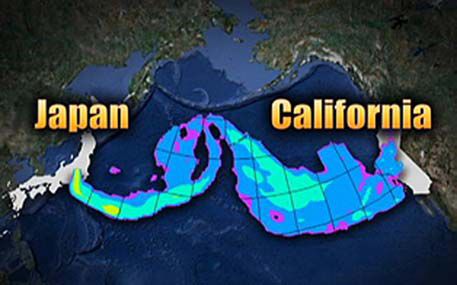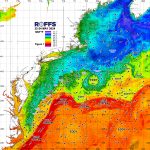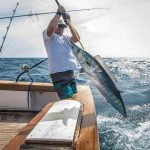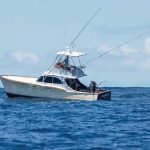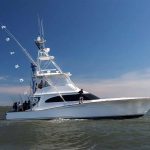This Should Be a Wake-Up Call That You Can’t Afford To Hit The Snooze Button On
I’ve been a commercial fisherman from Alaska to Antarctica for 40 years and have made it through hurricanes, gales and freak waves. I’ve seen the unregulated growth in the longline fishery here in Hawai‘i and the collapse and closing of the bottomfish and lobster fisheries in the Northwestern Hawaiian Islands. However, I’ve never been more frightened in my life of the sea or what is happening in our fisheries than now– and that’s while I sit here safe at my desk writing this.
Since the 2011 Japanese tsunami, a number of studies have been conducted to determine what effects marine debris and other contaminants have had on the ocean and marine life. Individually, the results are scary, but when you connect the dots, they point to a catastrophic event that is now brewing in the Pacific. These aren’t assumptions or hypothetical models; these are the facts about what is happening right now. When you add them all up and realize they are all happening simultaneously in the Pacific, the ramifications are beyond anything anyone ever imagined.
After the tsunami, some said that the “best-case scenario” would be for the estimated 55 billion lbs of debris discharged into the ocean to sink or “break down into smaller pieces,” called micro-plastics. Unfortunately, they were wrong.
According to scientists, there have been alarming signals of unseen threats to the marine ecosystem of late. In the North Pacific Central gyre, researchers found six times more micro-plastics than zooplankton– a crucial food source that every species of fish, marine mammal and ultimately humans depend on. Scientific studies also show persistent organic pollutants (POPs), which are organic compounds resistant to environmental degradation. These pollutants stay in the environment and are capable of accumulating in human and animal tissue once they enter the food chain. POPs will have significant impacts on human health and the environment.
When the UN recently came out with an initiative to address marine debris on the high seas, which was led by Brazil, the European Union, Argentina, Mexico, Monaco and developing nations, and proposed an international agreement to modernize governance of the high seas, the United States opposed it.
In a recent article in the Los Angeles Times, Richard Branson (Virgin Atlantic) and James Cameron wrote: “The United States has been the single most significant obstacle to a new high seas agreement, with the State Department citing potential opposition from members of Congress who are critics of the United Nations. Spearheading negotiations on the conservation and management of the high seas could give the United States a big win on a global issue. It would level the playing field by making sure that activities on the high seas are subject to the same kinds of requirements routinely imposed on ocean industries in U.S. coastal waters. I do not believe it makes sense to hold this hugely important ocean conservation initiative hostage to possible opposition in the Senate or unspecified potential concerns by unnamed interests. This is not leadership.”
Scientists have determined that more than 30 percent of the plastics being manufactured should be classified as toxic waste, from food containers to fishing gear. They want to classify PVC, polystyrene, polyurethane and polycarbonate as the most hazardous/toxic plastics, because when these plastics start degrading, they leach toxic chemicals. That means they also may leach toxic chemicals into the fish that have consumed them. Researchers estimate that fish living at intermediate depths in the North Pacific swallow as much as 24,000 tons of plastic debris a year.
The National Academy of Sciences just published a study conducted by Washington State University that found compelling evidence that Bisphenol A (BPA) may negatively impact women’s reproductive systems, causing chromosomal damage, birth defects and miscarriages. Bisphenol A is used as a hardener in many plastics.
A recent University of Hawaii study indicated that as much as 58 percent of one species tested had micro-plastics in its stomach contents. The fish that showed these results were opah. Opah, or moonfish, are mid- to deep-water feeders. What effect will micro-plastics (that are concentrated in the upper water columns) have on fish such as tuna, which feed at the surface? While some tuna were tested, the study was not focused on tuna. In addition, the samples were taken in a wide area of the Pacific. My question is, “What effects do micro-plastics have on fish that feed in the upper water columns and spend much of their time in highly concentrated areas of debris known as gyres that we know are inundated with six times more micro-plastics than zooplankton?”
In all fairness to the researchers, the study covered a wide area so they could get a sampling from around the Pacific and Hawai‘i. However, if fish are sampled from areas where there is less debris, does that dilute the overall findings? In other words, if the fish near the epicenter of the debris fields have significant amounts of micro-plastics in their systems and are lumped in with fish that feed and are found in areas with less debris, would the overall findings look different? Unfortunately, when I asked this question of the researchers, they could not disclose specifics of where the samples were taken, as required by law, so the question remains unanswered.
Yet another study has shown that zooplankton and plankton, the food sources for many species including Alaska salmon and many of the fish we depend on for food, are attaching themselves to this micro-plastic, making it even more enticing for fish to consume. Coho and sockeye salmon that spend the first few years of their lives feeding north of Hawai‘i depend on plankton and zooplankton and spend a great deal of their early life in waters inundated with debris and microplastics–and now a radioactive plume from Japan.
Another recent finding involved bluefin tuna caught off San Diego. The fish migrated from waters in Japan after the radioactive water was released into the Pacific Ocean. The scientists said, “The results provide ‘unequivocal evidence’ that the fish had carried Fukushimaderived radioactive material across the ocean over the course of their easterly migration,” but they claimed it would have no adverse impacts on human health. You have to ask yourself, “What is this doing to the tuna’s ability to reproduce?” and, “What effects is it having on their physiology and genetics?” What long-term biological effects will it have? And what, if any, effects can be passed along to humans who consume the fish long term even if the radiation levels are not harmful?
Another recent report found that mercury pollution from power plants in China and India has been found in fish near Hawai‘i. A study done by the University of Michigan found that mercury produced by coal-burning power plants moves thousands of miles through the atmosphere before rainfall deposits it on the ocean floor. It’s then passed on to humans who consume fish such as tuna and swordfish.
New reports now indicate that a radioactive plume from the failed Japanese nuclear reactor will reach the United States’ west coast in 2014. While the scientists say that the radioactivity will be diluted and not pose a problem to humans, what happens to the marine life that is going to be exposed to this plume for months or years? Will it affect their reproduction? Will it kill large volumes of a food source such as zooplankton and plankton that salmon, tuna and other species found in this area depend on? When fish species consume toxic micro-plastics as well as plankton and zooplankton that are soaking in radioactive waters, what is that going to do to our food supply and human health? And what combined health risks does it pose to us if these fish do develop problems such as endocrine disruption that can be passed on to humans and cause tumors, birth defects and autism?
Eighty-five percent of the worlds’ population depends on the ocean for 35 percent of its protein. Even if you don’t eat fish, what will the loss of healthy seafood mean to food prices across the board? We’ll have to supplement the lost protein with something. And what will it do to the world economy if we have to provide even more aid to developing countries that depend on seafood, just so they can survive?
Solutions
The lack of research to develop new solutions suggests that this situation is not being given the priority it deserves. While many people have their own ideas for addressing the issues, I’ve only seen a few that seem to have practical applications. For instance, in China and other coal-burning countries around the world, a reasonable solution could be to eliminate or significantly reduce toxic emissions. President Obama just put those requirements on U.S. coal power plants. Some tests show that emissions can be captured and circulated through algae. This helps the algae grow to produce renewable algae oil, and reduces the contaminants. Such systems have been tested for the past three years. They remove most of the hazardous emissions and make the end product more carbonneutral. They’re doing this successfully here in the United States and in England.
I realize we can’t control what China and these other countries do to their own populations and environments, but when their actions start affecting the rest of the world, wouldn’t sanctions by the United States and UN be appropriate? Let’s make their performance in controlling their emissions contingent on imports. Let’s stop importing some products if they’re using these power plants to manufacture them.
While there’s no way to remove tiny particles of marine debris or micro-plastics given how deep they are in the water column and how large the ocean is (not to mention all the plankton and zooplankton that would be killed and removed along with them if we tried to use trawl nets to remove them), the United States and the UN must develop an international effort that will create a rapid response to the next disaster like the tsunami in Japan. We may not be able to clean up micro-plastics already out there floating around, but hundreds of millions of pounds of larger debris could have been removed soon after the tsunami if there had been a response plan. Letting debris drift and disperse for years and then trying to remove it at sea is not only more difficult, but much less cost-effective. Do we wait for an oil spill to wash up on our beaches to clean it, or do we send boats out to the source of the leak or spill to clean it up before it disperses over large areas?
As far as marine debris, it’s always going to have a variety of sources. Container ships lose hundreds of containers a year and pay nothing toward recovery or cleaning up the material that washes overboard every week. If the shipping companies didn’t stack their containers so high to maximize the ship’s capacity to reduce costs, maybe they wouldn’t be losing them overboard. Shouldn’t there be a penalty for those shipping companies that lose containers? They get reimbursed for the insurance claim on the container, but nothing is paid for cleaning up the mess.
The same applies to fishing gear. Yes, fisherman lose gear. No, it can’t be avoided. But in some cases gear such as trawl nets are thrown overboard and cut away because it’s easier than returning it to port for disposal. There should be a fee attached to every piece of trawl or seine net, and that gear should be registered. When you retire the gear, the fee could be returned. Millions of Americans do it everyday with each soda bottle they buy. If you can’t account for it, the fee could be used for debris collection or mitigation.
However, with lobbyists for the seafood industry, plastic manufacturers and oil companies putting pressure on Congress not to take action or support international efforts to find solutions, nothing will happen. We give oil companies and others huge government subsidies to find and produce oil, but there is not one subsidy for a company that will collect marine debris made from this same oil that is killing marine life and poisoning the food chain.
Research
Another key to the equation is research. The redundancy in research projects has gotten ridiculous. Some researchers have turned into “grant junkies” looking for their next fix, and they don’t care where they get it. They’re so worried about sustaining their staff and operations that they don’t consider what research is a priority. They look to what is politically correct and what’s making headlines. Ten scientists can be studying the same thing and all claiming their results are the best. Enough already.
We know where the debris is and where it goes. Now we need research to determine the best ways to collect and dispose of it. Studying currents and wind patterns does not solve the problem, but it gets scientists more research grants. You get researchers wanting to know why Styrofoam from the tsunami ends up in Alaska and nets and heavier debris end up in Hawai‘i. That’s simple: Styrofoam is lighter, sits higher above the water and is driven by the wind so is blown to Alaska and the West Coast while other debris is heavier with more drag so it is driven by ocean currents and ends up in the gyre or around Hawai‘i. Ask any fisherman. We’ve been looking for debris to fish around for years. But researchers want millions of dollars to study this phenomenon to death when real research is needed in areas like collection, rapid response plans and the effects of micro-plastics and contaminants on the food chain.
I ask if there has been any assessment of the Northwestern Hawaiian Islands and the Great Pacific Garbage Patch for Plastic Contamination. Does the marine debris that has broken down have an effect on marine life? Has it caused endocrine disruption as it has in Chesapeake Bay? If species are affected and can’t reproduce, does that also affect monk seals, bottom fish and lobsters? We don’t know because the studies haven’t been done.
Some groups are pushing the EPA to get involved under Section 105 of the Comprehensive Environmental Response, Compensation, and Liability Act (CERCLA), 42 U.S.C. § 9605, the Environmental Protection Agency (EPA) should be required to look at this information and conduct studies to determine if micro-plastics and plastic pollution is a risk to the environment and public health. It should also expand the study to the high seas, Oh, but wait, the United States is standing in the way of the UN doing just that. CERCLA was enacted “to alert the appropriate government officials to releases of hazardous substances that may require rapid response to protect public health and welfare and the environment.” 50 Fed. Reg. 13,456 (April 4, 1985). Unfortunately, nothing like this is being done.
It’s simply amazing that instead of doing studies like this in the Northwestern Hawaiian Islands, we do studies to determine if ‘opihi grow bigger and if they’re more abundant in the Northwestern Hawaiian Islands or the Main Hawaiian Islands. Yes, you read that correctly. They did a study.
I have nothing against ‘opihi. I love them as much as the next guy, but is that really a priority? Could it be there are more people picking ‘opihi in the main Hawaiian islands than in the Northwestern Hawaiian Islands? Could it be that since more people are picking them in the main Hawaiian islands, they don’t grow as big, so they produce smaller offspring? I’m shocked that the researchers spent important research money on this issue at a time when so much more is going on.
Scientists have known for years that when we fish, we usually take the biggest fish and throw the smaller ones back. This removes the largest fish from the population, and the average size of the species drops. If the fishing pressure is great enough, the smaller fish left behind breed and they, therefore, have smaller babies. It’s the whole reason behind marine protected areas: protecting the bigger fish that can produce more eggs and have bigger babies. Why do we need to study this when we should be trying to determine the effects of micro-plastics or endocrine disruption on fish, birds and humans in the Northwestern Hawaiian Islands and other places?
I mean no disrespect to the researchers. It’s not their fault. It’s good research, and I’m sure that their intentions are honorable. It’s the fault of those who wrote them a check and didn’t prioritize what is needed right now to help protect us and every living thing in the Pacific from a catastrophic collapse. There is no one making these hard decisions. Sometimes what we do know can hurt us, because if we know, we have to address the problem. So not knowing seems to be the only agenda right now. Then the powers-that-be can repeat their famous mantra when asked the hard questions: “We don’t have enough information yet!”
The average person believes that there are laws and health codes that will protect us, but when these same laws are subject to loopholes or when political agendas get in the way of common sense, we’re in serious trouble. Most people see marine debris on the beach and think it can’t hurt them. But when you consider that the debris you see only represents 1 percent of what is circulating around the Pacific, soaking in radioactive water and mercury and being consumed by the fish we eat, it should scare the heck out of you.
. . . Bob Endreson – Hawaii Fishing News

